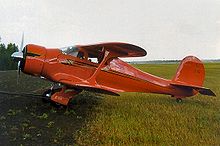31:
20:
170:
Lift comes from having air at a lower pressure above the wing than below. In the case of aircraft with more than one wing, one above the other, the higher pressure below the upper wing and the lower pressure above the lower wing will tend to equalize and so reduce the lift available. The closer
171:
together the wings are the more dramatic is this effect. The effect can be reduced by either increasing the gap between the wings, or moving one forward of the other. As increasing the gap may introduce other undesirable effects, stagger is usually applied to reduce the loss of lift.
153:
is the distance from the leading edge of the upper wing along its chord to the point of intersection of the chord with a line drawn perpendicularly to the chord of the upper wing at the leading edge of the lower wing, all lines being drawn in a plane parallel to the plane of symmetry.
162:
As a general rule, there is a tendency for the upper wing to contribute a greater proportion of the total lift than the lower with positive stagger, and less with negative stagger. Increase in positive stagger also tends to move the
174:
Positive stagger is by far the most common, as this positioning of the upper wing(s) allows better visibility for the crew as well as increased aircraft longitudinal
167:
forward on the upper wing and backward on the lower wing. When unstaggered, the centers of pressure for upper and lower wings are almost coincidental.
164:
258:
216:
35:
343:
98:
149:
had a stagger of 0.91 m and a gap of 2.0 m, so the stagger might be written as 0.91 m, 0.455, 45.5% or 24.5°.
86:
67:
82:
24:
300:
270:
234:
321:
110:
254:
212:
81:, when the upper wing is positioned forward of the lower (bottom) wing, Examples include the
51:
175:
94:
146:
106:
337:
93:
in unusual cases where the upper wing is positioned behind the lower wing, as in the
125:
say, but it may also be written as a fraction or percentage of the 'gap' (distance
101:. An aircraft with the wings positioned directly above each other is said to have
30:
285:
289:
The Air Forces on a
Systematic Series of Biplane and Triplane Cellule Models
16:
Distance one wing is positioned in front of another in a multiwing aircraft
312:
Charles
Hampton Grant. Model Airplane Design and Theory of Flight (1941).
238:
Wind Tunnel
Pressure Distribution Tests on a Series of Biplane Wing Models
187:
63:
43:
274:
The
Distribution of Loads Between the Wings of a Biplane Having Decalage
59:
19:
55:
29:
18:
327:(September 1921), pp.1,3,4. Retrieved on 9 February 2009.
137:. It may also be presented as an angle equal to tan(
276:(November 1927), p.3. Retrieved on 9 February 2009.
240:(July 1929), p.17. Retrieved on 8 February 2009.
121:The value is sometimes expressed as a distance,
301:Biplane and triplane wing lift and efficiency
253:. (1971). London: Putnam Publishing Co. Ltd.
8:
178:, aerodynamic efficiency and maximum lift.
89:. Conversely, an aeroplane is said to have
291:(1927), p.6. Retrieved on 9 February 2009.
303:George White. Retrieved on 2nd Nov 2020.
230:
228:
211:(first ed.). Osprey. p. 250.
199:
7:
325:The Effect of Staggering a Biplane
14:
54:fore-aft positioning of stacked
36:Beechcraft Model 17 Staggerwing
1:
286:NACA technical report No.256
271:NACA technical report No.269
235:NACA technical report No.310
73:An aircraft is said to have
322:NACA technical report No.70
251:Gloster Aircraft since 1917
23:Positive wing stagger of a
360:
99:Beech Model 17 Staggerwing
209:A Dictionary of Aviation
207:Wragg, David W. (1973).
83:de Havilland Tiger Moth
25:de Havilland Tiger Moth
39:
34:Negative stagger of a
27:
129:between wings), i.e.
33:
22:
344:Wing configurations
165:center of pressure
111:Vickers Vildebeest
40:
28:
249:James, Derek N.,
105:wings, as in the
351:
328:
319:
313:
310:
304:
298:
292:
283:
277:
268:
262:
247:
241:
232:
223:
222:
204:
91:negative stagger
75:positive stagger
50:is the relative
359:
358:
354:
353:
352:
350:
349:
348:
334:
333:
332:
331:
320:
316:
311:
307:
299:
295:
284:
280:
269:
265:
248:
244:
233:
226:
219:
206:
205:
201:
196:
184:
160:
119:
95:Sopwith Dolphin
17:
12:
11:
5:
357:
355:
347:
346:
336:
335:
330:
329:
314:
305:
293:
278:
263:
242:
224:
217:
198:
197:
195:
192:
191:
190:
183:
180:
159:
156:
147:Gloster TSR.38
118:
115:
107:Sopwith Cuckoo
15:
13:
10:
9:
6:
4:
3:
2:
356:
345:
342:
341:
339:
326:
323:
318:
315:
309:
306:
302:
297:
294:
290:
287:
282:
279:
275:
272:
267:
264:
260:
259:0-370-00084-6
256:
252:
246:
243:
239:
236:
231:
229:
225:
220:
218:9780850451634
214:
210:
203:
200:
193:
189:
186:
185:
181:
179:
177:
172:
168:
166:
157:
155:
152:
148:
144:
140:
136:
132:
128:
124:
116:
114:
112:
108:
104:
100:
96:
92:
88:
84:
80:
76:
71:
69:
65:
61:
57:
53:
49:
45:
37:
32:
26:
21:
324:
317:
308:
296:
288:
281:
273:
266:
250:
245:
237:
208:
202:
173:
169:
161:
150:
142:
138:
134:
130:
126:
122:
120:
102:
90:
78:
77:, or simply
74:
72:
47:
41:
117:Measurement
103:unstaggered
194:References
68:multiplane
52:horizontal
176:stability
38:in Alaska
338:Category
261:page 204
188:Decalage
182:See also
87:Stearman
64:triplane
48:stagger
44:aviation
158:Effects
145:). The
79:stagger
60:biplane
257:
215:
66:, or
58:in a
56:wings
255:ISBN
213:ISBN
109:or
97:or
85:or
42:In
340::
227:^
113:.
70:.
62:,
46:,
221:.
151:s
143:g
141:/
139:s
135:g
133:/
131:s
127:g
123:s
Text is available under the Creative Commons Attribution-ShareAlike License. Additional terms may apply.

